|
| 2007 Featured Article Archive |
|
| |
|
|
|
|
|
|
|
|
|
|
|
|
|
|
|
|
|
| |
|
| ~ December 31, 2007 ~ |
Hoof Disease And Prevention
by C.J.Hessley Farrier Services |
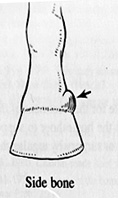 |
Side bone or ossification of the lateral cartilage is a loss of flexibility of the foot cartilages. |
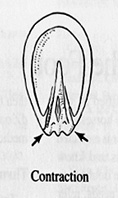 |
Contraction is foot bound or atrophy of the hoof that is drawn together at the buttress causing a constriction of the foot. |
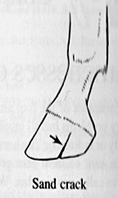 |
Sand crack is a vertical crack in the hoof wall, flares or unbalanced feet may cause cracks. |
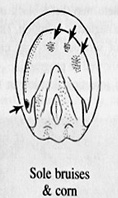 |
Corns start as bruises in the sensitive sole in the angle formed by the wall and bars. A dry corn is a red circular bruise in the seat of corn area. The redness is caused by ruptured blood vessels draining into the horn tubules. |
 |
Abscess, gravel or puss pocket is an infection of the sensitive structure |
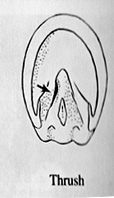 |
Thrush is a common disease of the frog. Anaerobic bacteria primarily reasonable. |
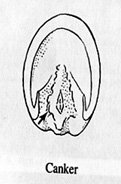 |
Canker or hoof cancer is a vegitive growth of the sensitive frog. Hoof cancer is caused by constant conact of strong ammonia compounds. |
 |
Founder or lamanitise is caused by endotoximia, over feeding. Rotation of the coffin bone. |
| Navicular disease: bursitis or inflammation of the synovial fluid filled sacs between the articular cartalige of the navicular bone |
 |
Horse owner responsibilities
Make appointments two weeks in advanced and keep them.
Have the horse caught and held in a dry safe area.
Provide a good place to work- level and dry, plenty of light, shade if hot, safe and no “spooks”(children pets machinery etc.)or wire traps.
Be available to hold the horse. If this is not possible, provide someone who is familiar to the horse. A horse will generally stand better for someone it is familiar with.
Handle the horse’s feet regularly. Keep them free of disease. Tie the horse for long periods to teach it to stand quietly for the shoeing.
Inform the horseshoer of any behavioral or foot problems the horse may have.
Have the horses feet clean and soft before the shoer comes. Overfill the water tank, it may take several days in dry weather. Hoof dreassing is usually not nessesry. Do not apply hoof dressing 24 hours before the shoer comes. (It make for a greasy mess)
Take care of the horse. Schedule a re-shoeing before the hoofs become overgrown and the shoes lost. Realize shoeing is a regular event.
Pay the horseshoer when he does the work.
Be loyal to your horseshoer. Remember that the best horseshoer will be the cheapest in the long run. |
|
| ~ December 17, 2007 ~ |
 |
BACKCOUNTRY HORSEMEN OF CALIFORNIA
Redshank Riders Unit
by Sherli Leonard |
The high desert land around Anza beckons riders to take to the trails for long stretches of uninterrupted quiet time. Through the efforts of Redshank Riders Unit of the Backcountry Horsemen of California, many of those trails stay open and safe. According to former unit president Terri Pirillo, Redshank Riders has three main goals: To keep the trails open, to educate the public about Gentle Use of the backcountry, and to have fun while enjoying backcountry and wilderness activities.
To keep the trails open, the unit conducts several work parties each year to clear debris, move downed trees, repair damage from erosion, and lop away overgrowth. Sometimes, they have to re-arrange the trail to make it safer.
While this sounds like a lot of work, members consider the trail work as a way to give back for the right to ride deep into backcountry where few people go.
Redshank Riders have adopted the Cahuilla Mountain Trail to maintain throughout the year, and at least once each year, members hike or pack into the trail to do their work. They usually follow the work party with a potluck and then a “victory” ride to enjoy their efforts.
The unit also conducts education and outreach activities, beginning in the spring with their Trail Trials, a full day event to expose riders to safe trail riding practices. They distribute pamphlets on all manner of trail-related information, and help riders assess their personal skill levels and make appropriate adjustments. Every rider, regardless of experience, learns something at this event.
In the summer, they hold another full-day program, called sun-fun-education-horses-trails and you [Yup, no caps], offering a full slate of speakers and presenters with demonstrations and exhibits to further educate the public about trail use. This event is free of charge for participants.
To expose the public to Backcountry Horsemen of California techniques and ideals of Gentle Use, the unit also participates in the Anza Fourth of July Parade, leading fully-packed and appropriately patriotic stock animals along the parade route.
In addition to the work parties and the public outreach, the unit simply has fun, participating in several formal and informal rides throughout the year. The highlights include the Garner Valley Ride, with riders camping over at the dry camp area, or trailering in for the day before they ride. At the conclusion of the ride, they gather for a barbecue and raffle. The November Turkey Treasure Hunt brings non-members to learn about the unit’s activities, and join, of course.
Equestrians from the Anza and Aguanga area and as far away as Temecula and points south are invited to join the Redshank Riders Unit and enjoy the full benefits of riding in the backcountry. Membership dues cost $40 per year, and a portion of the dues goes to the statewide organization to support the group’s efforts.
For more information, go to the Website, www.redshankriders.com. |
|
| ~ December 10, 2007 ~ |
| …Would you like to dance? The pleasure is mine, said the horse… |
Invitation to dance
It’s one gray morning in October, the smell of rain is still in the air,
fall is coming with its warm colors and cool temperatures.
People are trickling in, enjoying coffee and pastries, while registering for the event. Carolyn Resnick is already by the ring, getting to meet everybody and answering questions before the clinic starts. This is the second of a series of three clinics designed around one horse’s progress. The purpose of this is to give people the most complete and explanatory view on Carolyn’s method also known as Liberty Training. |
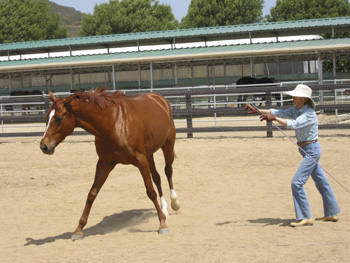 |
Music is in the air, Fred Benedetti is playing live his classic guitar and everything seems to call for a dance.
After a brief introduction about the basics of her method to communicate with horses, Carolyn let in the ring Panadero XLVI, a talented three year old PRE stallion, accompanied by Shelley Martin, World Champion of Cutting.
Panadero is in the ring tack less, he moves in unity with Carolyn because they understand each other’s body language. There is no need for tack to keep the horse near, he wants to be close to her, there is no need to push, Panadero moves with her like he would do in united movement with another horse. Not the way horses generally move around people, but the way they move in a group of horses.
All of this is made possible because of the relationship that the Carolyn Resnick Method builds between the horse and his human partner.
Here is the dance!
From the ground Carolyn and Panadero move in complete synchrony, and shortly after, Shelley rides him without using the reins, mounted on a halter just as a precaution. She is able to stop the horse at her whim, just by using her body to tell him when.
Being ridden is the major new milestone for Panadero since the July clinic.
The uplifting feeling that I got from watching the performance was powered by the extreme trust everyone could see, being present, between Panadero, Carolyn and Shelley. They were performing, without the contact that the tack gives to the rider, yet still achieving the desired response.
When time came for me to bring in the ring Downtown Rosalie, my six years old TB off the track since February, everybody was still talking about how beautiful and easy Panadero’s performance was. It seemed magic!
Rosalie doesn’t like crowds and was particularly full of energy that morning, showing off with a big jump and buck as soon as I removed her halter and gave her a choice.
In the audience somebody was wondering if she was a bucking bronco instead of a race horse.
Like nothing happened, in a couple of minutes, Carolyn and Rosalie , were walking together like Panadero was earlier. The whole picture seemed so easy and natural that it took a moment, for the audience, to realize that the same horse, that was jumping in the air, now was dancing with Carolyn. The mare undoubtedly understood and followed her lead.
When working with a horse with the Carolyn Resnick Method there is an active and polite dialogue, the horse is always respected, given the choice to participate and never reduced into submission.
The horse chooses his leader to follow, like it happens in nature. Instead of submitted, the horse becomes the willing and enthusiastic partner of a dance that translates from the ground to the horse’s back. What makes the communication so clear is, literally, the secret language of horses. They are all familiar with it. It’s the one that the herd speaks.
Our horses are not herd animals, in most cases. We can also try to breed out or in qualities, but we cannot change the horses instincts, inborn in the species for the time they have been on earth. The foal will always shadow his mother from birth, will always learn from her when to eat and when not to eat and look up to other horses for company and counseling.
Carolyn Resnick, developed a way to communicate with horses in her youth, through rituals that she observed happening between the horses in a wild herd. She adopted those rituals, made her body act like the horses she was studying and experimented with it to see their response. Her efforts were so good that the horses accepted Carolyn as a member of the herd, including her in their pecking order. |
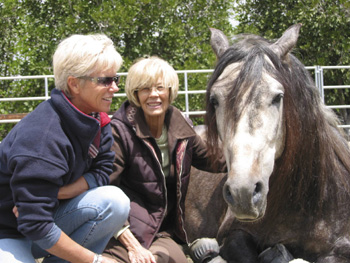 |
Her language is the foundation that any and every person interested in horses should have. It enables to really touch the heart of the horse by talking its own way. It speaks of being together in friendship, sharing space and food, moving in synchrony, respecting each other and choosing a leader.
Any and every horse should approach training from this point of view, respecting, trusting and choosing their human as a friend, a partner and a leader, not viewing us as a predator that they would naturally fear.
If the horse chooses a leader to follow he will do so, from just being together in the moment to a very fine performance.
Throughout her carrier Carolyn has concentrated her efforts in coding and perfecting her communication system to give people and horses a better way to understand each other.
After the great outcome of the July and October clinics, Carolyn Resnick, leading authority in equine behavior and communication and internationally known author of Naked Liberty, will hold a winter clinic on January 12th, for more information about the event contact Carolyn’s office at: carolynresnick@cox.net.
The Carolyn Resnick’s Method can be a foundation to all equestrian pursuits and will provide you with new techniques and skills on how to bond, maintain respect and use body language to achieve unity and optimum performance, from the ground to the saddle, with your horse.
This is a rare opportunity to work directly with Carolyn Resnick and learn her technique,
a real breakthrough in equestrian training. |
|
| ~ December 4, 2007 ~ |
"I Ride" A Testament to Women
by Julia Dake |
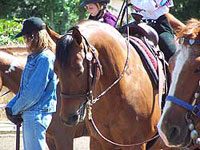 |
I ride. That seems like such a simple statement. However as many women who ride know it is really a complicated matter. It has to do with power and empowerment. Being able to do things you might have once considered out of reach or ability. I have considered this as I shovel manure, fill water barrels in the cold rain, wait for the vet/farrier/electrician/hay delivery, change a tire on a horse trailer by the side of the freeway, or cool a gelding out before getting down to the business of drinking a cold beer after a long ride. |
| The time, the money, the effort it takes to ride calls for dedication. At least I call it dedication. It's a sickness I've had since I was a small girl bouncing my model horses and dreaming of the day I would ride a real horse. Most of the women I ride with understand the meaning of 'the sickness'. It's not a sport. It's not a hobby. It's what we do and, in some ways, who we are as women and human beings. |
| I ride. I hook up my trailer and load my mare. I haul to some trailhead somewhere, unload, saddle, whistle up my dog and I ride. I breathe in the air, watch the sunlight filter through the trees and savor the movement of my horse. My shoulders relax. A smile rides my sunscreen smeared face. I pull my ball cap down and let the real world fade into the tracks my horse leaves in the dust. |
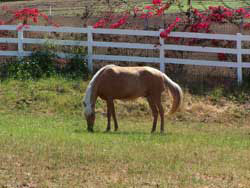 |
| Time slows. Flying insects buzz loudly, looking like fairies. My mare flicks her ears and moves down the trail. I can smell her sweat and it is perfume to my senses. Time slows. The rhythm of the walk and the movement of the leaves become my focus. My saddle creaks and the leather rein in my hand softens with the warmth. |
 |
I consider the simple statement; I ride. I think of all I do because I ride. Climb granite slabs, wade into a freezing lake, race a friend through the sage all the while laughing and feeling my heart in my chest. Other days just the act of mounting and dismounting can be a real accomplishment. Still I ride, no matter how tired or how much my seat bones or any of the numerous horse related injuries hurt. I ride. And I feel better for doing so. |
| The beauty I've seen because I ride amazes me. I've ridden out to find lakes that remain for the most part, unseen. Caves, dark and cold beside rivers full and rolling are the scenes I see in my dreams. The Granite Stairway at Echo Summit, bald eagles on the wing and bobcats on the prowl add to the empowerment and joy in my heart. |
| I think of the people, mostly women, I've met. I consider how competent they all are. Not a weenie amongst the bunch. We haul 40ft rigs, we back into tight spaces without clipping a tree. We set up camp. Tend the horses. We cook and keep safe. We understand and love our companions, the horse. We respect each other and those we encounter on the trail. We know that if you are out there riding, you also shovel, fill, wait and doctor. Your hands are a little rough and you travel with out makeup or hair gel. You do without to afford the 'sickness' and probably, when you were a small girl, you bounced a model horse while you dreamed of riding a real one. Now you're there….ride. |
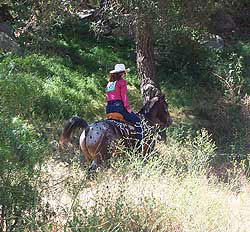 |
|
| ~ November 16, 2007 ~ |
Backcountry Horsemen of California
Welcomes all Recreational Trail Users |
 |
SPECIAL FOR SOCALEQUINE.COM:
If you ride the backcountry and wilderness trails of Southern California, you’ve probably run into pack mule trains, looking like they just stepped out of a painting of the 19th century Old West. Most likely, these mule trains belonged to members of the Backcountry Horsemen of California, and they were carrying trail maintenance tools and supplies.
This statewide organization has more than 4,000 members in 27 individual units, including eight units in Southern California alone. Riders of all ages and all skill levels, with or without pack stock, are invited and welcomed to join any of the regional units.
They talk in their own language of panniers and rock bars and grip hoists and Dutch ovens as they ready their riding and pack stock to head deep into the wilderness. They repair high mountain trails, they build new ones, and often times they load up horses and mules just for the fun of it, the fun of loving the demands and intrigue of packing for a week at a time near a remote mountain meadow.
It’s a rugged side of the sport of horses that demands every bit the precision and detail and excellence of approach as one would expect in the dressage arena. Pull a strap too tight, miscalculate a distance, forget to pack a tool, midjudge a horse’s attitude, and the planned backcountry excursion turns sour and potentially life-threatening.
This is the world of packing with stock. |
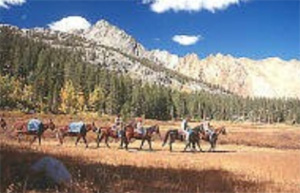 |
In 1981, the organization coalesced around the threatened closure of backcountry trails which had been open, always, to hikers and equestrians. Forming with the idea of working with public land managers to take care of trails and wilderness areas, the organization quickly morphed into a full service group with 10 main goals in three major categories:
1, Take care of the backcountry trails and open spaces; 2, Advocate maintaining access to backcountry; and 3, Educate the public about Gentle Use.
A “typical” BCHC weekend involves at least as many pack animals as riding animals. With their stock loaded with McLeods, axes, shovels, loppers, and an occasional grip hoist, and their basic supplies of food and camping equipment, BCHC members move out of camp after an early morning cup of freshly-brewed Cowboy Coffee. They are bound for somewhere along the trail where Mother Nature, whether in the form of cloud bursts or fires, has made the trail dangerous or impassable. Generally, power tools are forbidden.
“Those of us who subscribe to the wilderness philosophy believe that we should keep things as they used to be,” explained BCHC member Bill Carter, one of the coordinators for this summer’s repair and maintenance work in the Inyo Forest. “No motorized vehicles, no power equipment, only primitive tools. For most maintenance, this works well, and it allows us to maintain this important part of our heritage.”
This past summer, units around the state assisted the US Forest Service, the National Park Service, the BLM, and the Pacific Crest Trail Association with repairs in remote areas. The work they accomplish keeps trails open and usable for all backcountry users. And they do it all at no cost to the government.
Besides volunteer work, BCHC members plan and coordinate educational activities to raise awareness of the fragile environment of the wilderness. The Redshank Riders Unit in the Anza area recently held a full day of clinics and demonstrations about everything from snakes you may encounter to Dutch oven cooking to emergency vet care on the trail. The Mother Lode Unit staffed the Gentle Use Camp at the Western States Horse Expo in June with help from Sutter Buttes Unit. Several Southern California units staffed the booth at the Los Angeles County Fair throughout most of September.
Equally important to service and education, advocacy forms the third BCHC leg. The organization works with local, regional, state, and federal agencies and organizations to keep the backcountry trails and forage areas open to horsemen on all public lands. They keep current information before the membership and its local units regarding new legislation or management plans related to government regulations of the backcountry. They also review new proposals, plans, and restrictions as related to the interest of horsemen and those persons interested in recreational stock use in the backcountry.
Not every BCHC member packs, however. Many simply camp and trail ride and go to work on the trails when they can reach them in truck or on foot.
“Most of us who don’t pack still support the work the BCHC does to keep the wilderness trails open,” said member Tracey Stahler-Roche of Redlands. “We help when we can, and otherwise just have a good time with the group.” |
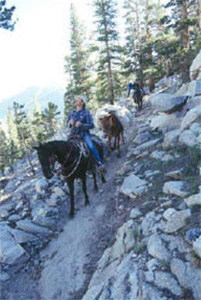 |
The BCHC’s Southern California units frequently have access to areas their members otherwise couldn’t get to. For a minimal $40 annual membership fee, riders can join a local unit, contribute to the care of the recreational trails, help educate the public about Gentle Use and Leave No Trace, and otherwise ride deep into the backcountry and wilderness to escape the chaos of civilization.
Riders in the San Diego area can join one of three units: Caballeros Del Sol in El Cajon 858-278-9088; Redshank Riders in Anza and Aquanga 951-767-0168; or the San Diego Unit in Ramona, 760-788-0354.
The Inland Empire area is represented by two units: San Gorgonio Pass Unit in Beaumont, 951-676-4897; and the Santa Ana River Unit in Norco, 951-278-0448.
In the high desert, riders can join one of three units: Antelope Valley Unit in the Palmdale area, 661-944-4927; the Mojave River Unit in Hesperia, 909-489-5470; or the Los Padres Unit in Santa Maria, 805-481-0401.
BCHC welcomes all equestrians, with or without pack stock. To learn more about the BCHC, visit the Web site at www.bchc.com, or call 909-389-7810. |
| Photos from the Antelope Valley Unit Web site |
|
| ~ October 31, 2007 ~ |
Anatomy and Physiology of the Hoof
by C.J.Hessley Farrier Services |
The hoof is divided into five different sections, the wall, the sole, and the frog, the periople and the white line. The hoof grows as a result of stratum germinativum. Cell layers. The hoof wall is the primary weight bearer. The rate of foot growth is important when considering physiology. Rapidly growing hoofs usually have a higher quality and easer to keep properly shod. The hoof rate seems to be directly correlated with the heart rate. The frog is used as a pumping mechanism to bring blood into the foot. The sole is horney tissue that protects the sensitive structures inside the hoof capsule.
The periople ring is a narrow ring that is located just above the coronary band. The periople protects the sensitive coronary band at he junction of the skin and hoof next to the hairline.
The connection of terminal papilla and stratum lamellateum make up the white line (zona lamellatum). The white line is used as a guide for nailing on shoes.
Familiarize yourself with these terms.
Know what you are looking at, this diagram should help: |
 |
Gait: A is a pattern of movement or way of going. Gaits are characterized by variations in the stride. Stride is the term given to the action of the leg between successive front prints or tracks made by the same foot.
Balance: an even distrobution of weight enabling something to stand upright and steady.
Disease: a disorder of structure or function in an animal. An animal not at ease is considered to be diseased.
Imbalance: resulting from over trimming one area of the hoof.
Foot flight patterns: the path in which way the foot moves in direction of gait
The ideal foot is one that is functional and symmetrical. The outer surface of the wall is smooth and strait from the coronary band to the ground.
Winging-in: Usually associated with a toed-out conformation. The feet usually break over the inside of the toe and move in an inward arc.
Winging-out: Usually associated with a toed-in conformation. Wining-out is often called paddling.
Stumbling: Interference with the ground.
Interfering: Interference between opposite limbs.
Forging: Interference with the bottom of the front shoe hitting the toe of the hind shoe.
Overreaching: Is interference between the toe of the hind shoe and the bulb or heels, of the front shoe on the same side.
Knee hitting: Is also called knee knocking, is interference between the inside of a front foot and the knee region of the opposite leg
Elbow hitting: Interference between the shoe and the elbow of the leg it is on.
Cross fire: Interfering with the opposite (diagonal) front and hind feet
Speedy cutting: High limb interference at speed.
|
C. J. Hessley
Farrier Services
socaliprorodeo@yahoo.com |
|
Results of the Extreme Mustang Makeover
By Marta Zarrella |
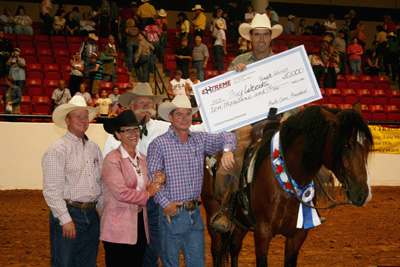 |
Extreme Mustang Makeover finals judges, from left, J.D. Yates,
Suzy Jeane, Bob Moorhouse and Chris Cox congratulate champion Guy Woods of Pilot Point, Texas, and his American Mustang Max. (Weslie Elliott photo) |
“I’m having a hard time putting into words what this event has done for the wild horse and burro program,” Bureau of Land Management (BLM) Chief of the Wild Horses and Burro Division, Don Glenn, who was almost speechless with the weekends success. The Will Rogers Equestrian Center in Fort Worth was filled to capacity on Saturday and Sunday September 22 & 23. “This event has brought more attention to what we are doing to preserve the American Mustang than any other program in my 30 years with the division. I have to give a tremendous amount of credit to the trainers who took these Mustangs and shaped them into marketable horses. Without them, there is no way this event would have been successful.” Mr. Glenn also complimented the Mustang Heritage Foundation for their time and effort organizing the event.
One hundred trainers were selected out of a pool of two hundred twenty applicants back in the spring. The trainers were randomly paired with one hundred wild mustangs for one hundred days of training before the two-day competition and subsequent adoption auction on Monday, September 23. Seventy-five Mustangs were adopted for a total of $233,100. The average bid per horse was $3,108. Historically, wild mustangs sold at auction bring in less than $1000 on average. The BLM receives $125 per head as the minimum adoption fee. The remainder has been allocated for programs of the BLM while this year a portion also went to the Mustang Heritage Foundation to support their programs as well. Trainers in the Extreme Mustang Makeover also received a 15 percent commission for any horse adopted for a fee higher than $250. This year, there were two extremely high bids, both made for personal and very special reasons. More on that below.
So, how did our friend Micah do? Trainer Kathe Smothers of Quiet Mind Horsemanship in Ojai experienced a bit of frustration, as did many other trainers: going off course, flashing cameras, and other challenges of such a large well attended first time competition. There were 36 teams receiving “zero score” for the In Hand portion, 29 got “zero score” for the Horse Course portion. The conditioning scores ranged from a 27.5 low to a 38 high. Kathe and Micah had a false start during the riding portion. Going back into the starting area, Micah became startled by the thousands of spectators, flashing cameras and was spooked by the timekeeper. All of that led to a less than relaxed and forward ride, but Kathe says, “I just sat down, smiled and rode him through the test.” They went off course during the In Hand, earning a zero score for that segment. Micah’s conditioning score was a 35, on the high end of scores for that segment. Even with a zero In Hand score and a difficult ride, Micah and Kathe placed in the top half with a combined final score of 126.75 .
During his short time in Ojai, Micah earned many fans. Kathe’s students raised $8,000 for her to take to Fort Worth with the goal of bidding on Micah during the adoption auction. Kathe was able to buy the horse back for one of the highest sale prices of the day, $7500. “I feel Micah is a good representation of the Nevada Range Mustang and what can be done with them with correct handling.” Micah will become an ambassador for Kathe’s Quiet Mind Horsemanship program. We will stay in touch with Micah’s career and bring you updates periodically.
A Calico Mountain Mustang named Larry, trained by Dave Schaffner from Texas sold for $10,000. Dave Schaffner tragically suffered a serious riding accident on another horse shortly before the competition and was not able to compete. As a result, Larry was shown by Shaffner’s son Tyler as a tribute to the hard work his father put into this horse. Tyler’s scores did not count toward the competition since he did not do the training. That did not matter to Larry and friends of the Schaffner family, the horse was adopted for $10,000. The funds received for Larry, after paying BLM fees, were donated to the Schaffner family to assist with Dave’s medical bills. |
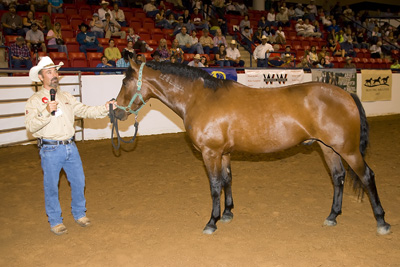 |
| The American Mustang Hail Yeah, shown with trainer Ray Ariss (Darrell Dodds photo) |
One horse was purchased for a whopping $50,000. That was Hail Yeah, trained by Norco trainer, Ray Ariss. Ray and his wife, Pippa, own and operate Star Brite Riding Academy in Norco where they teach all ages and all disciplines, however Dressage is a favored specialty. In 2004, Ray earned IEL Dressage Trainer of the Year. Like others, Ray and Hail Yeah went off course in the Horse Course portion, earning a combined total score of 105.85 and a conditioning score of 37. That did not matter, Hail Yeah had already made an impression on Norco’s Mayor, Harvey Sullivan and on the Mustang Heritage Foundation (MHF) who collaborated with the City of Norco on the bid. “I thought this competition was so unique and Ray is an outstanding trainer,” said Sullivan, who traveled to Fort Worth to support Ariss and Hail Yeah. “When I return to Norco, we will be naming Hail Yeah the official mascot of the city and he will represent our message as Horsetown USA.”
“With this partnership, Hail Yeah will serve as an incredible example of what the American Mustang is and can be to people interested in owning a great horse,” said MHF Executive Director Patti Colbert. “The city of Norco doesn’t just call itself Horsetown USA, it is Horsetown USA, and having Hail Yeah there in Norco and traveling the country with Ray Ariss will do so much to raise the awareness of the value of Mustangs.” Look for more stories on Hail Yeah and Horsetown USA in the future. |
|
| ~ October 6, 2007 ~ |
Tribute to Merv Griffin
by Gayle Cady |
A true gentleman and legend amongst the people.
Guardian angel and protector of horses.
Merv Griffin, a kind and gentle man of kindred spirit, and impeccable charm.
He exemplified a wholesome lust for life. He succeeded in living his dream.
He created "Griffin Ranch" for himself, and others to enjoy.
He has been quoted as saying:
"Retirement is death. I do not want to check into a house on a golf course."
We are so very blessed and fortunate to have known Merv Griffin; both as a friend and neighbor. His ingenuity, foresight, and insatiable love for horses has created virtual foundation for furthering his inspirational dreams and desire for making a difference in this community.
City Officials of La Quinta have a golden opportunity to preserve, protect, and carry on the integral concept of Merv Griffin's accomplishments at Griffin Ranch.
What better way to honor this great man than to embrace his dream by firmly establishing an entirely genuine "equestrian lifestyle" community. Amend the General Plan to include furthering an agricultural theme. Extend existing borders allowing for and "encouraging" horse ownership. Make preparations for creation of a premier world class equestrian community second to none. La Quinta has exclusive opportunity to accomplish this as a fitting memorial to Merv Griffin. Take advantage! Welcome the challenge!
La Quinta is already a champion in providing a magnificent network of multi-purpose trails throughout the southeastern portion of the City. However, the City has been quite shy in promoting and advertising these trails for horseback riding. Their existence outside of our immediate area is virtually unknown. It is time to break the "shyness", exercise your "bragging rights", and launch into a new challenging area of life. Again, La Quinta has the exclusive opportunity to pursue following in Merv Griffin's vision for this portion of the Coachella Valley.
"THE GRIFFIN TRAILS, La Quinta, California" has a phenomenal ring to it.
A quote from Merv Griffin: "You have to be constantly turning the page, which prevents me from getting caught up in negativity. It's all about change for me. I keep moving and enjoy the ride."
(The Desert Sun - August 10, 2007)
Capture the moment.
|
|
Dear Friends,
Norman and I have written this brief commentary in which we discussed our personal feelings regarding the tragic death of Merv Griffin; and how the Coachella Valley, specifically the City of La Quinta, might reflect its respect and acknowledgment for his personal vision of creating an equestrian lifestyle community amongst the hubbub of country club, golf courses, and mania urbanization.
Thank you for reading the above "Tribute to Merv Griffin".
If you feel our suggestions have merit and potential for creating a worthy testimonial to Merv Griffin, and/or if you have additional ideas; please be sure to make La Quinta (and Riverside County) aware of your feelings.
Written correspondence should be addressed as follows:
City of La Quinta Riverside County
Attn: Doug Evans, Assistant City Mgr. Attn: Roy Wilson, 4th District Supervisor
Attn: City Council Members 73-710 Fred Waring Drive - Suite 222
P. O. Box 1504 Palm Desert Ca 92260-2574
La Quinta Ca 92247-1504
It is our sincere hope to gather immense interest and enthusiasm for continuing Merv's vision here in perpetuity. Already we have world class polo, and the universally recognized premier performing Desert Circuit Horse Show in the Sun "HITS" nearby.
Merv had absolute love and devotion for horses. He chose to live the "equestrian" lifestyle with all the potentially wonderful amenities it has to offer in the city of La Quinta. This is the place. It's the right thing to do.
For those of you who may not live in the immediate area, or may not be personally involved with horses......It isn't nearly as important as you wanting to participate in our mutual desire to honor the legacy bestowed upon us by Merv Griffin.
So, everyone, please write a letter. Thank you!
Sincerely,
Gayle Cady
760-398-2724 (Home Phone)
82-831 Avenue 54
Vista Santa Rosa, Ca 92274-9554 |
|
| ~ September 24, 2007 ~ |
A Note to My Owner
by Marta Zarrella |
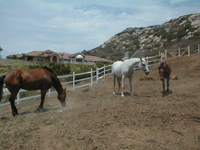 |
Anyone who has been around horses for any amount of time has seen a feisty, reactive, nervous horse. Those of us who have been at it for a while have seen novice owners trying to deal with those horses. Most of us have been bruised and scraped. Others have been battered and broken by our beloved equine friends. If they could, our horses might write us something like this… |
| Dear Owner,
Do you know how much you confuse me?
I am a herd animal. I live every day of my life using my big nose, huge nostrils, large eyes, and big ears to monitor the world around me so that I can protect myself to live another day. I know as a prey animal, my herd mates help me stay safe. My relationship with them is very important to my health and well being. I need to understand you to figure out where I am in your herd.
It is my job to be respectful to my superiors. I move out of their way when they approach me, I stay at or behind their shoulder to show respect. I bow to them to show that I look up to them. They have proven themselves to be smarter, faster or stronger so they are the ones I trust to keep me safe. I also keep those below me in the herd respectful and mindful. I push them out of my space if they do not give to the pressure of my eyes and my body. I will nip at their chest or their butt and hind legs to move them. I will keep pressure on them, making them move away from me until they bow respectfully showing they will keep their attention on me for guidance. I might try to push you around until I learn my place with you.
You stand in front of me and try to touch my face that makes me very nervous. My herd mates only stand directly in front to challenge me, they go for my face when they are trying to hurt me. You walk into my blind spots where I can not see you, but I certainly hear and smell you. When you move fast, I might try to run away out of fear or respect. I get REALLY crazy and confused when you’re angry that I moved, because by moving I am trying to “respect your bubble” and keep myself safe.
I DON”T UNDERSTAND YOU!!
Then, you put all of this heavy, uncomfortable equipment on me and think that I can move like I do with nothing on. My body has to get used to carrying all that stuff, especially something as tall, heavy and awkward as your body. I worry that you might fall off of me so I go sideways under you or slow the help you and you hit me with a whip, kick me, or put more straps of leather on me. I JUST DON”T understand you? I can smell when you are nervous, so I get nervous also and then you get angry at me. I am taking my lead from you, so again, I am confused! When you ride me and suddenly get stiff, that scares me. It hurts my back a little too. It’s hard for me to move freely when you sit up there stiff and hollow, I can’t be round and soft.
You and I need to get to know each other before we can be a good team. I would love to spend time getting to know you on the ground. Free longe me in a round pen, learn to read my body and give me a chance to learn about you. I have heard from some of my friends that there are trainers who can help teach you how to “join up” with me, teach you how to relax and be light on my back so I can be light underneath you. I can teach you some of this stuff if you let me, but it might be safer if you let another qualified human teach you.
Also, PLEASE, talk to my vet about making sure you are not hurting me by accident. Be certain the equipment you use fits me correctly. I can’t feel your hands if the bit is pinching my mouth or if the leather is so tight I can’t feel anything but pressure on my face. Then there is the saddle. The wrong saddle can cause a lot of damage to my spine, my loins and my shoulders. It is hard for me to be happy to see you if my body is in pain because of something you used on me.
Also, take care of my legs. And my feet, make sure they are clean and balanced. It is hard for me to work if my legs and feet hurt. Like you, my muscles and tendons need to build up to the work we are asking of them. If you always work me on hard ground, and suddenly take me to the beach for a long beach ride, my legs are going to be REALLY sore!!! I have seen some pretty cool leg wraps, knowing when to use them will help me and my legs stay sound for you. Another thing is stretching and warming up, like I see you guys doing. The more you let me stretch and warm up my bones and muscles before work, the better they will work for us and the longer they will stay healthy. When my body is sore, I might not be too happy to see you. Please think about that before you get angry at me.
I really want to be a great partner. I am excited to learn new things with you. I will try my best to understand what you want from me, please, though, try to learn my language so we can communicate better..
Love,
Your horse
|
|
| ~ September 17, 2007 ~ |
Extreme Mustang Makeover
by Marta Zarrella
On Saturday, September 22, 2007, the “Extreme Mustang Makeover” will launch a new chapter in the history of America’s Wild Mustang.
Horses play a huge role in the American story. Spanish explorers in the mid 15th century reintroduced them to the continent. The heritage of the Mustang includes a variety of different breeds brought to this country and set free by explorers from around the world. Our modern day American horse - the wild Mustang - is strong, smart, with good feet and a healthy body. |
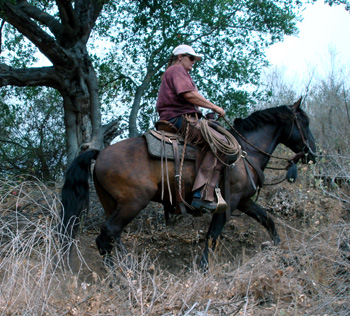 |
Beginning with the Wild Horse Annie act of the 1950’s to the Wild Free-Roaming Horse and Burro act of 1971, our government has been enacting laws to help preserve these treasures of American History. The goal is to manage the wild herds in ways that helps them to remain safe, healthy, and strong. The problem is these horses reproduce freely so their numbers grow beyond what the land itself - forage, water, and shelter - can accommodate. Controlling herd size makes them welcome residents of public rangelands in 10 Western states where they roam. |
For years now, the Bureau of Land Management (BLM) has been capturing wild burros and mustangs. They are sold through public auctions held around the country. This year the BLM and the Mustang Heritage Foundation, a 501c3 charity, added a new twist to the annual adoptions. 100 trainers from 30 states (10 Californians) were randomly paired with 100 wild mustangs for the first ever Wild Mustang Makeover Competition. The event was designed to demonstrate the versatility of these horses and improve their adoptability through the training aspect of the competition.
In September, the trainers will show off what they have accomplished since picking up their wild horses in early June. The Mustangs will be judged on conditioning, groundwork, and the ability to navigate a trail course. This “Horse Course” includes several obstacles requiring specific maneuvers. The obstacles are things encountered in trail and recreational riding situations. Some of the tasks could be opening a gate, crossing a bridge, possibly navigating water and maybe even loading into a trailer.
One California based trainer selected for the competition was Kathe Smothers of Ojai. Kathe’s motto is “Don’t sell the horse, fix the problem”. Kathe’s mentor is Buck Brannaman, the widely respected horse gentler, teacher and author. Kathe has attended clinics with Buck several times a year since 1992. She feels it is important to keep up her education so that she can do the best job possible for her students. Every human helped means at least one more horse will have a better life. Kathe’s been a Hunter/Jumper trainer. She’s also a dressage enthusiast and loves trial. Right now the primary focuses of her business is colt starting and problem horses. |
| Kathe did not spend time with her assigned horse, 3 yr old Micah, until getting him home. Micah began his adventure with Kathe not at her barn, but at a quiet peaceful place owned by a friend. There Micah had a round pen, which fed, into a 12x24 corral, which fed into a 24x24 box stall. There were two other horses on the property so Micah had friends to help him through the big transition. Day one he was in the round pen, the only goal for that day was for Micah and Kathe to get to know each other. Kathe used her lariat to touch him repeatedly for about an hour and a half allowing him to feel comfortable in her presence. Kathe’s philosophy of horse training is mutual respect. Taking the time to build a trusting relationship is step one of a successful relationship with any horse, a wild mustang or an expensive show horse. |
 |
By the second day, Micah was eating out of his feeder in the box stall. On that second day, Micah learned about fly spray. He had a runny eye, getting the flies off that eye was a priority. Micah understood very quickly that the scary wet stuff meant no flies. Kathe began grooming Micah in that first week, handling his feet, doing many things that felt good to him. Kathe was ready to move Micah from her friend’s house to the busy barn when the horse showed her he was ready. He responded to her daily greeting with a turn in her direction, a happy eye and relaxed body posture. Prior to that, Micah always came out of the stall when he heard Kathe’s truck approach, but his body was not relaxed and his face was alert and fearful. Learning how to read the horse and pushing them only as far as they can handle is critical to “Natural” horse training.
Micah started under saddle work at the end of July. By the second ride, they were out of the round pen and into the arena. The third ride was out of the arena and out on trail. Micah loves trail, but is also comfortable doing arena work. In a short 3 months Micah has had his feet trimmed by a farrier, had fly eggs removed from his drippy eye by a vet, taken several rides in the trailer, met an enthusiastic crowd of fans. He’s been a well behaved gentleman and very proud every time. When the Vet was finished removing the irritant from his eye, Micah reach out his nose as if to say “thank you”.
Kathe has worked with mustangs before; Micah is one of the smartest, most trusting and most appreciative horses she has ever worked with. When asked what the biggest challenge of this Extreme Mustang Makeover competition has been, Kathe said it was having to give up this wonderful horse.
Micah and his 99 friends will see each other again on September 22 in Fort Worth, Texas. That is when the 100 teams of horse and trainer will be put through their paces. The trainer deemed to have done the best job with their horse will receive a $25,000 prize. All of the horses will be up for adoption immediately after the competition. For more information on the competition and links information on the trainers involved, visit the Mustang Heritage Foundation website at www.mustangheritagefoundation.org.
For information on the Mustangs and other BLM, programs visit http://www.blm.gov/wo/st/en/prog/wild_horse_and_burro.html
Kathe Smothers
Quiet Mind Horsemanship
www.quietmindhorsemanship.com
805-798-0234 |
|
| ~ September 7, 2007 ~ |
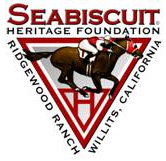 |
Sonoma County Thoroughbred Rescue Operation
to Benefit from special tour of Seabiscuit Ranch,
N. California home of horse racing legend
News Release 9/7/07
‘You don’t throw away a life
just because it is banged up a little’ |
Willits, CA – Friends, fans and supporters of Seabiscuit and the Seabiscuit Heritage Foundation are invited to tour Ridgewood Ranch, home and final place of the horse racing legend in Willits, CA, on September 15 and show their support for Glen Ellen Vocational Academy, an equine retirement foundation operated by Pam Berg in nearby Sonoma County.
Berg and a handful of volunteers are rescuing and providing care for injured and retired thoroughbreds so that they can recover and return to riding soundness, just as Seabiscuit once did under his trainer Tom Smith. Tom Smith’s nephew James Watkins along with his wife Lucy are both avid supporters of GEVA and help provide sponsorships for individual retired horses.
Representing GEVA will be Sharon Harms, a Santa Rosa Junior College professor who has been a volunteer for some 4 years. GEVA was founded to provide homes for injured, retired, and abused horses, or horses just in need of a home.
Representing the Seabiscuit Heritage Foundation will be Jacqueline Cooper, owner and breeder of the American Legend Horse Farm which is raising Seabiscuit’s descendants, and Seabiscuit Foundation President Tracy Livingston. The foundation is a nonprofit group formed to protect and preserve the historic buildings and natural resources of the remaining 5,000 acres of the original ranch. A life-sized bronze sculpture of the equestrian giant recently was unveiled and formally dedicated there.
When Livingston and Cooper were bringing the newly crafted statue of Seabiscuit back to the ranch from Salt Lake City, GEVA was one of the ceremonial whistle stops made enroute. Ironically, GEVA was where the vintage van carrying the Seabiscuit statute broke down. So Seabiscuit, who Tom Smith instinctively understood to need companions, enjoyed the companionship of 29 thoroughbreds for several hours.
"You don’t throw away a life, just because it is banged up a little."
Tom Smith - Acadamy Award-nominated movie Seabiscuit
"I believe, Charles Howard [owner of Seabiscuit] would have given Pam Berg a smile and nod of approval for her rescue efforts," said Cooper. "After all, Seabiscuit himself was nursed back to health after he suffered what was thought to be a career ending injury." Nestled in the oak and redwood-studded ranchlands and mountains of northern California, Ridgewood Ranch was where Seabiscuit recovered after rupturing a suspensory ligament. His recuperation set the stage for an electrifying blaze-of-glory career finish at Santa Anita Park that captivated Depression-era America.
Washoe Valley Sal, a Seabiscuit descendant, will also make an appearance. "We are very grateful to individuals such as Pam Berg and Pam Forgash of Jaynesville, CA who have taken it upon themselves to find suitable homes for rescued horses through their horse adoption programs. Washoe Valley Sal is such a rescue and we are very happy to report that she is now in foal and an integral part of our Lil’Biscuit breeding program." Cooper added.
Cooper purchased a stallion season to benefit Glen Ellen Vocational Academy donated by Harris Farms earlier this year. Washoe Valley Sal was recently bred to Downtown Seattle (by Seattle Slew) at Harris Farms, a full service Thoroughbred breeding operation located in Coalinga, CA and is due to foal next May. "We thought it would be most appropriate to purchase a stallion season to support Geva," said Cooper.
This is one of many stallion seasons offered annually at online auction to benefit GEVA. Thoroughbred breeders are encouraged to check back online this fall for the 2008 Stallion Season Auction. Yet another great roster of stallion seasons is anticipated. Donations for Glen Ellen Vocational Academy are also accepted and help provide feed, housing, and care for the horses of GEVA. For more information please visit: www.glenellenfarms.com/geva
The general public is invited to tour Ridgewood Ranch to benefit GEVA, Saturday, September 15th. Reservations must be made in advance by calling the Willits Chamber of Commerce at 707-459-7910.
***
GEVA inc. is a nonprofit organization with a 501 (c)(3) status granted by the IRS. Donations to the foundation are TAX DEDUCTIBLE.
Still a working ranch, Ridgewood has been designated one of America’s most threatened historic places by the National Trust for Historic Preservation. The current owner, Christ’s Church of the Golden Rule, has endeavored to be a model steward of the ranch by keeping developers at bay and by permanently protecting the historic structures that constitute Seabiscuit’s legacy.
For more information, contact the Seabiscuit Heritage Foundation, @Ridgewood Ranch, 16200 North Highway 101, Willits, CA 95490 e-mail: seabiscuit@instawave.net or visit www.seabiscuitheritage.org |
|
| ~ September, 2007 ~ |
County Opens Barnett Ranch Preserve in Ramona
County of San Diego ~ News Release |
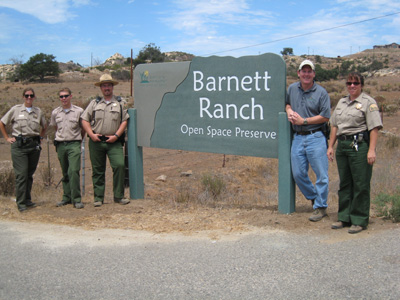 |
| The County Parks and Recreation Department will be opening Barnett Ranch Preserve to the public for the first time on Saturday, August 4, 2007. The 700-acre preserve in Ramona offers the public access to approximately four miles of trails through a variety of habitats. From the late 1800s until recently, Barnett Ranch was a working ranch that raised cattle and grew field crops. The County acquired the land for inclusion in the Multiple Species Conservation Program (MSCP) Subarea Plan, and now the public is welcome to hike, bike, or ride horses along its trails and enjoy the wildlife and scenery preserved in the park. “Barnett Ranch is a welcome addition to the County’s nationally recognized MSCP plan,” said 2nd District Supervisor Dianne Jacob, who helped create the MSCP program in the 90s. “It highlights the County’s ability to provide recreational opportunities for the public, while preserving its valuable natural resources.” |
| The new preserve encompasses habitats ranging from coastal sage scrub to oak savannah to nonnative grasslands. Visitors can enjoy the scenic views from the miles of multiple-use, non motorized trails, and can observe wildlife including golden eagles, white-tailed kites, orange-throated whiptail's, and the rarely seen ringtail. |
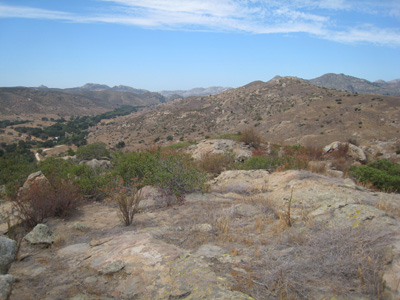 |
| The staging (entrance) area of Barnett Ranch Preserve is located at the intersection of San Vicente Road and Deviney Lane in Ramona. The preserve will be open Fridays through Mondays, from 8 a.m. to sunset. No water or restroom facilities are available at the preserve. |
View a map of the Barnett Ranch Preserve Area here
For more information please visit www.sdparks.org or call 858-565-3600. |
|
| ~ August, 2007 ~ |
Trail Trips of Southern California
By Sherli Leonard
If you’ve ridden on a cattle ranch, immersed in a life of caring for cows, horses, the land, and each other, you know the powerful draw of ranch life. Southern California’s recreational riders, craving a respite from the mundane or the frantic, are seeking the ranch experience, and they’re finding it in Central California at two massive and historic cattle ranches: the V6 Ranch and the Work Family Guest Ranch.
My Trail Trips took me there this spring and introduced me to an amazing way of life and remarkable opportunities to be connected to the land, the sky, my horse, and good friends. Both working ranches have opened their gates to ranch-deprived equestrians, and each offers its own distinctive
approach. |
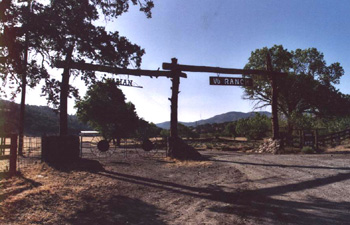 |
The V6 Ranch
Three miles outside Parkfield, the earthquake capital of the world, has an established horse camp and caters to groups of 20 or more. Their weekend events provide three extraordinary catered meals per day, trail rides, cattle work, clinics, fishing and swimming, and live entertainment at night. The camp in a grove of blue oaks features small-but-safe corrals for horses, water hookups for RVs and camping, good showers and toilets, and a huge three-sided dining lodge.
The ranch hosts four different 4-day cattle drives each year, three in the spring and one in the fall. You can use one of the experienced ranch horses, or bring your own.
This August 31 through September 3, the ranch will host its first Hoof Marks Expedition, a four-day event of a complete ranch experience, including trail riding, ranching, and relaxing. Guests will receive three extraordinary catered meals each day, cowboy clinics, and dancing and live entertainment, and will have full use of the 20,000 acre private ranch and over 50 miles of well-marked and safe trails that take riders high on the ridges above the valleys, including an expansive view of the San Joaquin Valley on the east. The price for the four-day stay is $695 per person.
Also on the schedule for this year is the Arabian Horse Association Trail Ride from September 26 through 30, featuring cattle sorting with Cowgirl Hall of Famer Sheila Varian; the Cowgirl University “Cowgirl 102” was held on July 20 through 22. Next summer, the ranch will add the V6 Ranch Singles Round-Up for four days in June.
Your riding group can book the ranch for a stay of trail riding and cattle working and receive three catered meals a day and access to the entire ranch for $125 per person per day. This could be a money-maker for your group. John Varian, who runs the events with his wife, Barbara, will work with you to plan an event.
“This isn’t a state park where you pull in and stay for a night or two to ride the trails,” John said. “It’s a working ranch, and we have to protect that.”
On one ride I took by myself, I rode through three major fields and negotiated 10 gates. Since Ronda is not gate-literate yet, I dismounted and mounted that many times, as leaving a gate the way you find it is basic ranch etiquette. Fortunately, I still have a little spring left in my boots.
“Once you have entered the world of mountains, you will look forward with joy to each successive return, as one looks forward to a return home . . . ,” wrote Russel Harrison Varian about the V6 Ranch. Already, I’m looking forward to a return trip to the magical world of V6 Ranch in Parkfield.
Terrain: 20,000 acres of rolling central California hills; oak-covered grassland, some creeks, dry in summer; 50 miles of trails covering a variety of terrain, many wide and well-maintained, all well-marked with way-finding signs.
Difficulty: Rider: Beginners should be very safe; Horse: intermediate and beyond.
Facilities at V6 Group Camp: water hookups for RVs, camping; good showers and toilets; large covered dining area; 10 x 10 paneled corrals for horses; shade from blue oaks.
Activities and costs: (3 catered meals/day, guided trail rides, clinics, entertainment, use of facilities)
Four-day cattle drives (Oct. 5-8, 2007): $750.00 person
Hoof Marks Expedition, four days (Aug. 31 – Sept. 3, 2007): $695.00 person
Group trails rides, 20+: $125 per person per day
Operating times: Available all year.
Directions: From Los Angeles and the Inland Empire, take I-5 north to Highway 46 and go west; or take 101 north to Highway 46 in Paso Robles, and go east; at the junction with Highway 41, turn north onto the road to Parkfield; follow the signs through the “town” of Parkfield (school, café, and Inn). The camp is three miles further, so make arrangements to meet John in town and he will guide you there.
Information: 805-463-2371; www.parkfield.com |
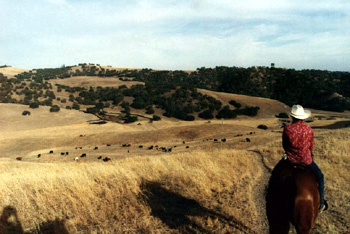 |
Work Family Guest Ranch:
Twelve miles away as the crow flies, the Work Family Guest Ranch covers 12,000 acres of rolling hills with sprawling oaks. Also a working cattle ranch, it offers its own authentic experience, a version simpler than that at V6.
The Work Ranch lies at the end of Hog Canyon about 10 miles north of Highway 46 near Paso Robles. It has ample space for several rigs, but no RV hookups at this time: come self-contained. The ranch provides paneled corrals for your horse and you’ll find water conveniently available.
Kelly Work runs most of the guest ranch operation, and she will accommodate your interest in addition to the regularly scheduled events. She plans a few Ladies’ Weekends, with trail rides over jeep roads and cattle trails all over their land, which seems to go forever.
Soon, the Works will GPS-map and sign all the trails on the ranch. Until then, you should definitely hire a trail guide to take you out. Otherwise you probably will get lost, albeit happily.
She also schedules several Youth Horse Camps each year. Children 8-years-old and up stay for four whole days and ride ranch horses for five hours a day. Kelly, a Certified Riding Instructor, fills their hours with lessons and fun activities.
Life on the Work Ranch, with the inherent responsibilities of caring for animals and the intimate connection to the land, weaves a spell over visitors who seek a respite from the mundane or the frantic. Horses settle in, spirits calm, and hearts rejoice for a few days.
Terrain: 12,000 acres of rolling central California hills; oak-covered grassland, scores of miles of trails, mostly wide jeep trails with smooth footing.
Difficulty: Rider: Beginners should be very safe; Horse: intermediate and beyond.
Facilities: Dry camping, portable toilets, no showers; portable pipe corrals, water nearby.
Activities and costs:
Day riding on ranch horse: $60 for 1.5 hours; Day riding on own horse: $25 per person per day, includes stall fees.
Overnight camping: $40 per rig.
Youth Horse Camp: Three and four days, $300 and $350, everything provided, including horse.
Women’s Weekends: Three days and nights, everything provided except accommodations; bring your own horse or use ranch horse - $750.00 per person.
Farm Stay: Call for costs; (805) 467-3362.
Operating times: Available all year.
Directions: From Los Angeles, Inland Empire, and points south: take I-5 north to Highway 46; go west to Jardine Road;
Or, take 101 north to Paso Robles to Highway 46; go east to Jardine Road.
On Jardine Road, go north three miles, cross Estrella River Bridge, and turn right on Hog Canyon Road; Stay on this road until it dead-ends into the Hog Canyon Extension and turn right; go about five miles until you reach the Work Ranch on the right, and turn in the second driveway.
Information and reservations: 805-467-3362; www.workranch.com |
|
| ~ July, 2007 ~ |
The Urban Horse
By Pam Bowman
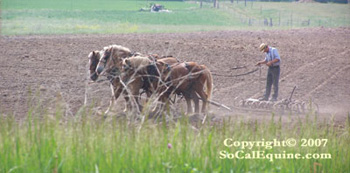
I recently visited the Midwest. Traveling down a back road through rural farmland, I happened on a sight that one would not expect to see…. an Amish farmer plowing his fields with a team of 4 Belgium draft horses. I though I had been time warped to another century. I pulled the car over, pulled out my camera and began shooting pictures of this special sight. Not much time had passed when a farm mate came pulling up in the field with another team of draft horses pulling a flatbed wagon. I felt so fortunate to catch such a sight.
|
Through the remaining portion of my trip, I reflected on the horse world, as we in the modern world know it and how it differs from the horse world, as they know it. The Amish still use the horse as our ancestors used the horse over 100 years ago. A horse’s daily lives consist of pulling wagons, buggies, plows, pulling stumps from the ground, moving lumber, bringing the crops in at harvest time, going to town for supplies and to carry the family to church on Sundays.
In days gone by, horses were really our forefather’s version of the tractor, the pickup truck, that 18 wheeler that hauls product to market, the family Chevy, the single man’s Ferrari, the taxi’s engines. These individuals were hard working honest horses. But by the turn of the last century, many of these horse jobs were replaced by the invention of the engine. As there was less need for horses to accomplish our every day human tasks, the number of horses dropped to roughly less than 30,000 horses nation wide by the 1920’s. |
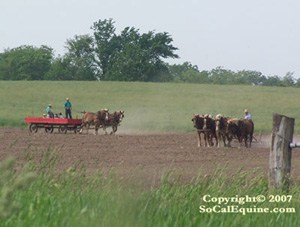 |
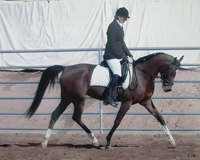 |
By the 1950’s the number of horses in the US was on the rise. As people found new use for horse in pleasure and recreation. Through showing at the county fairs, pack trips for photo shoots and hunting expeditions, to racing, and rodeos, the horse found a renewed partnership with people. |
| Today, there are hundreds of thousands of horses nationwide according to the American Horse Councils report in 2004. We use horses for recreation, for companions and as many of us know, having a horse is a whole lot cheaper than therapy on a stressful week at the office or in our everyday lives. Today’s horses lead a far easier life, not having to put in backbreaking days several days a week. |
Our urban horse has found a new place in our daily lives, taking a leisurely trail ride in the parks and backcountry, getting all dressed up for the horse show, helping their owners get a taste of what it was like to be a cowboy or cowgirl in days gone by. There are also a growing segment of farmers and horse people that are reviving the drafting of horses for logging, plowing and carriage throughout the country. Something the Amish have known to be an inexpensive and effective means of farming all along.
Today’s horse still has a place in our hearts and in our daily lives. I don’t think that will ever go away! To all of you horse lovers out there, Keep Horsin’ Around! |
 |
|
| ~ June, 2007 ~ |
Lisa St. John Cures Horse of Terminal Disease
Turquoise-eyed “animal miracle healer” cures the incurable
By Howard Straus
(reprinted with permission) |
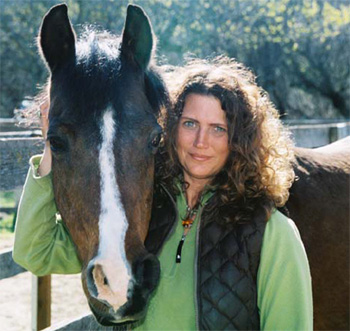
Lisa St. John and Foxy on March 2, 2007
Photograph by Bob Stone |
January 12, 2007 was a blustery, record cold morning in Northern California, the kind of icy chill that even the most hardy of horses would find challenging. On this cold morning, animal healer Lisa St. John and veterinarian Richard Clark had agreed to meet each other, for the first time, in the Carmel Valley home of Jack and Sylvia Schwadron, to observe the miraculous healing of Jack's horse Foxy, a 24-year old Arabian bay gelding and previous prize winning cutting horse.
In the middle of October 2006, Dr. Clark had sadly discussed with Jack and Sylvia that Foxy would have to be euthanized. His recommendation was based upon the following.
A year and a half previously, while Jack was riding, Foxy went down to his knees without warning, nearly tossing Jack. This was Jack's first serious indication of the progression of Foxy's failing joints. When it happened again, Sylvia insisted Jack stop riding him and let Foxy retire to pasture. Dr. Clark had been treating Foxy over the past several years by using nutritional support of methylsulfonylmethane (MSM), glucosamine and chrondroiton sulfate. In the middle of October 2006, Dr. Clark diagnosed Foxy with laminitis and severe arthrosis. Foxy’s joint inflammation was so severe it had caused both carpusus to fuse, his left front leg to twist and bow, and both front legs to swell to twice their normal size. Foxy could not lie down and was unable to walk properly. He had to use his shoulders to lift his stiff swollen legs.
Dr. Clark said that because of the increased joint discomfort Foxy would not be able to survive the cold weather which was on its way.
There was no doubt that Foxy should be put down, relieved of his continuous pain. Sylvia and Jack decided to make one last effort to help Foxy. They contacted Lisa St. John, who they had heard was able to bring about miraculous healings of diseased animals through her hands-on healing called “Rahseaka.” |

Foxy
Photograph taken by Lisa St. John at initial meeting of Foxy on October 28, 2006 |
| Lisa met Foxy October 28, 2006, describing it: "I first saw Foxy with his head hanging down, standing in pain, extremely uncomfortable. He saw me and attempted to move towards me. He wanted my hands on him." Sylvia watched with great interest, and was dumbfounded by the results of Lisa’s treatment. Sylvia explained, "As Lisa placed her hands on Foxy I saw pure love and compassion coming from her. I could not believe what came next. Within 15 minutes Foxy suddenly came back to life. His head came up; his eyes became bright; he turned and looked at Lisa and then literally took off. One minute he was incapable of walking and now he bounded into a trot and side stepped the length of the paddock!" Another of Lisa's miracles had begun. “We were amazed how rapidly Foxy responded to Lisa’s treatments over the next few weeks.”
After that first treatment Lisa had warned Jack and Sylvia that his healing process was far from over. Lisa told them Foxy would have two clearings (a healing process in which the patient’s systems flare up as the body rids itself of the illness) in order for him to completely recover. Two weeks later, they found Foxy lying down in his stall, stiff-legged with a high fever. Lisa had called Sylvia that morning to check on Foxy, predicting a clearing was going to take place in the next 48 hours. This was the clearing she saw coming.
Lisa sat down on the ground next to Foxy's belly and began her treatment, placing her hands on Foxy and bringing in the healing light of Rahseaka. Lisa explained to Sylvia that it was important for her to remain calm and reminded Sylvia that this was the healing process that needed to take place. Sylvia tried to remain calm while stroking Foxy's face. Foxy slept soundly as Lisa treated him, his legs relaxed and his fever left him. After approximately half an hour Foxy leaped up so quickly he knocked Lisa back and bounded out of his stall trotting. Lisa pointed out his leg to Sylvia; the leg which had been twisted and bowed was now straight.
Sylvia and Jack wanted others to know of Lisa St. John's incredible gift and arranged the January meeting with Lisa and Dr. Clark. Dr. Clark had not seen Foxy since he had advised euthanizing him in October. Over coffee he spoke of his diagnosis and explained that, "Such cases of advanced arthritis are progressive and not reversed by allopathic methods in animals, any more than they are in humans." |
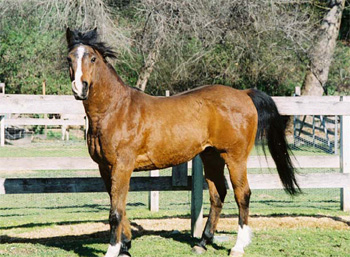 |
| Dr. Clark was then escorted to the stall to see Foxy and was completely stunned. "I'm amazed! I'm very excited!" Dr. Clark exclaimed as he watched Foxy walk gracefully out of his stall and begin to prance and trot comfortably around the paddock showing no signs of distress. Dr. Clark observed with astonishment the changes in Foxy: his eyes were now bright and full of life, unlike the lifeless pained look Dr. Clark remembered; the gelding's legs were now relatively normal in size; Foxy had freedom of motion and the twisted leg was no longer twisted and bowed. Foxy's winter coat was now thick and shiny, his teeth were healthy and white, and his skin and muscles, that had hung so slack on his bones only weeks earlier, were now taut and in condition.
Dr. Clark hugged Lisa with excitement and thanked her. With sincere interest he asked how she had helped Foxy, doing what nobody else had been able to do.
Lisa explained about the ancient healing art, Rahseaka, which was the means to Foxy's remarkable healing. This art, which Lisa uses, has been taught to her by no one; it is a gift. Lisa is a channel for her guides and she does not take credit for the many healings of her animal patients. "These animals are being healed by the guides who work through me." Intuitively Lisa knows what herbs to use and prescribes a special whole food nutrition program to specifically support the animal in the healing process.
Dr. Clark understood, quietly stating, "Lisa's healing art is far older than our modern medicine, an art that civilization has, unfortunately, long forgotten." |
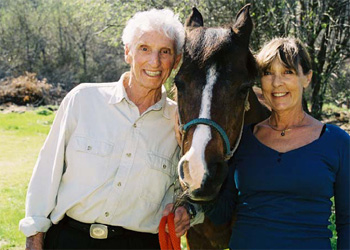
Jack and Sylvia Schwadron with Foxy on March 2, 2007
Photograph by Bob Stone |
Lisa St. John travels throughout the country successfully working with animals. Lisa's portfolio of healed and healthy animals is long and varied. Some of them can be seen on her website www.lavendernsage.com, often with before and after photographs.
Lisa's contact information:
Email: lavenderandsage@earthlink.net
Phone: 831-224-3314
Richard Clark is a veterinarian who owns a mixed animal practice in Monterey County, California. He received his DMV in 1983 and a Master of Preventative Veterinary Medicine in 1984 at the University of California, Davis. He is a wildlife veterinarian and has been a staff member at the UCD School of Veterinary Medicine and the California State Department of Fish and Game.
Howard Straus is a cancer clinic founder and president of the Gerson Miracle. He is an author, screenwriter and script consultant.
Bob Stone is a professional photographer from New York where he worked for Vogue Magazine.
Additional edits by Mary Helen Zelkovich and Maureen Meegan. |
|
| ~ May, 2007 ~ |
Dressage for the rest of us…
by Mishel Kocheran |
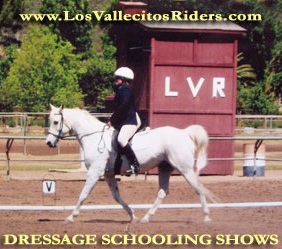 |
For a long time I have been thinking about writing an article about the importance of schooling shows here in Southern California, so now I put pen to paper.
There is such a need in our area for schooling shows. These shows are crucial to the dressage enthusiast who wants to prepare for the recognized shows. They are also important to the person who is training a green horse or is new to dressage. Trainers can bring their students to these shows to get the experience of being judged and making that perfect 20 meter circle. |
Los Vallecitos Riders in San Marcos currently has a show program that we invite you to attend. The next show will be June 3rd. It's always fun to see what kind of horses will be there and it's such a great learning point for the auditor as well as the rider. We have a beautiful arena at Walnut Grove Park in San Marcos and consistently get positive feedback about the footing in the arena.
If you belong to a riding club in your area and desire to hold schooling shows, I strongly urge you to get involved and start a show program. It’s fairly easy – all you need are good people, a little paper work, and some organization. Most any riding club would be happy to answer any questions you have about starting a show program. The friendships that develop are priceless and the learning is incredible.
I’m sure there are a lot of people like me who own horses and who enjoy dressage with a passion. These schooling shows not only provide excellent information for improvement of our horses, but give the experience needed to have the confidence to go on to the recognized shows.
One of the most important factors is the cost of these schooling shows. Their low entry fees are extremely reasonable, allowing everyone to participate. Whenever I have received a flier for an upcoming recognized show, I almost keel over when I figure out what the cost of one class is. At these schooling shows I can afford three classes for the price of one class at a recognized show. Granted, my goal is to school my horse and at this time not to go on to the recognized shows, but for everyone who is in the lower levels of training, these shows are perfect.
Los Vallecitos Riders is planning on continuing with our tradition of dressage schooling shows because of the response we received in the past. We will be having our second show on June 3, 2007 at Walnut Grove Park in San Marcos. Come on out and show your stuff!! We get wonderful “L” judges who give very honest comments and the footing in our arena is excellent.
If you would like information about our upcoming show, you can call Scott Martins at 760-518-1319 or email at sarandsco@netzero.net .
At Los Vallecitos Riders, we have english/western shows, complete with hunter hack and trail classes. We are family oriented and just like to have fun!! If you would like to join our wonderful riding club, you can go to lvrclub.com or call/email our President, Sue Dingess, at 760-743-2904, dingessfam@sbcglobal.net. |
|
| ~ January, 2007 ~ |
 |
From time to time, people tell me, "lighten up, it's just a horse". Or,"that's a lot of money for just a horse". They don't understand the distance traveled, the time spent, or the costs involved for "just a horse". Some of my proudest moments have come about with "just a horse". Many hours have passed and my only company was "just a horse", but I did not once feel slighted. Some of my saddest moments have been brought about by "just a horse", and in those days of darkness, the gentle touch of "just a horse" gave me comfort and reason to overcome the day. If you, too, think it's "just a horse", then you will probably understand phrases like "just a friend", "just a sunrise", or "just a promise". "JUST A HORSE" brings into my life the very essence of friendship, trust and pure unbridled joy. |
"JUST A HORSE" brings out the compassion and patience that makes me a better person. Because of "just a horse" I will rise early, take long walks and look longingly into the future.
So for me and folks like me, it's not "just a horse" but an embodiment of all the hopes and dream of the future, the fond memories of the past, and the pure joy of the moment. "JUST A HORSE" brings out what's good in me and diverts my thoughts away from myself and the worries of the day. I hope that someday they can understand that it's not "just a horse" but the thing that gives me humanity and keeps me from being "just a woman". So the next time you hear the phrase "just a horse", just smile, because they "just" don't understand.
~ Jerry Vaughn |
|
| Return to Featured Articles Archive |
| |
| |
| |
| |
| |
| |
|
|